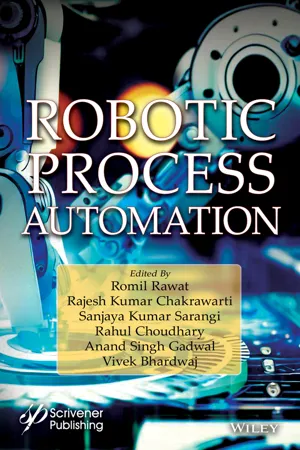
Robotic Process Automation
- English
- PDF
- Available on iOS & Android
Robotic Process Automation
About This Book
ROBOTIC PROCESS AUTOMATION
Presenting the latest technologies and practices in this ever-changing field, this groundbreaking new volume covers the theoretical challenges and practical solutions for using robotics across a variety of industries, encompassing many disciplines, including mathematics, computer science, electrical engineering, information technology, mechatronics, electronics, bioengineering, and command and software engineering.
Robotics is the study of creating devices that can take the place of people and mimic their behaviors. Mechanical engineering, electrical engineering, information engineering, mechatronics, electronics, bioengineering, computer engineering, control engineering, software engineering, mathematics, and other subjects are all included in robotics. Robots can be employed in a variety of scenarios and for a variety of objectives, but many are now being used in hazardous areas (such as radioactive material inspection, bomb detection, and deactivation), manufacturing operations, or in conditions where humans are unable to live (e.g. in space, underwater, in high heat, and clean up and containment of hazardous materials and radiation). Walking, lifting, speaking, cognition, and any other human activity are all attempted by robots. Many of today's robots are influenced by nature, making bio-inspired robotics a growing area. Defusing explosives, seeking survivors in unstable ruins, and investigating mines and shipwrecks are just a few of the activities that robots are designed to undertake.
This groundbreaking new volume presents a Robotic Process Automation (RPA) software technique that makes it simple to create, deploy, and manage software robots that mimic human movements while dealing with digital systems and software. Software robots can interpret what's on a screen, type the correct keystrokes, traverse systems, locate and extract data, and do a wide variety of predetermined operations, much like people. Software robots can do it quicker and more reliably than humans, without having to stand up and stretch or take a coffee break.
Frequently asked questions
Information
Table of contents
- Cover
- Title Page
- Copyright Page
- Contents
- Preface
- Chapter 1 A Comprehensive Study on Cloud Computing and its Security Protocols and Performance Enhancement Using Artificial Intelligence
- Chapter 2 The Role of Machine Learning and Artificial Intelligence in Detecting the Malicious Use of Cyber Space
- Chapter 3 Advanced Rival Combatant LIDAR-Guided Directed Energy Weapon Application System Using Hybrid Machine Learning
- Chapter 4 An Impact on Strategical Advancement and Its Analysis of Training the Autonomous Unmanned Aerial Vehicles in Warfare [Theme - RPA and Machine Learning]
- Chapter 5 FLASH: Web-Form’s Logical Analysis & Session Handling Automatic Form Classification and Filling on Surface and Dark Web
- Chapter 6 Performance Analysis of Terahertz Microstrip Antenna Designs: A Review
- Chapter 7 Smart Antenna for Home Automation Systems
- Chapter 8 Special Military Application Antenna for Robotics Process Automation
- Chapter 9 Blockchain Based Humans-Agents Interactions/Human-Robot Interactions: A Systematic Literature Review and Research Agenda
- Chapter 10 Secured Automation in Business Processes
- Chapter 11 Future of Business Organizations Based on Robotic Process Automation: A Review
- Chapter 12 Comparative Overview of FER Methods for Human-Robot Interaction Using Review Analysis
- Chapter 13 Impact of Artificial Intelligence on Medical Science Post Covid 19 Pandemic
- Chapter 14 Revolutionizing Modern Automated Technology with WEB 3.0
- Chapter 15 The Role of Artificial Intelligence, Blockchain, and Internet of Things in Next Generation Machine Based Communication
- Chapter 16 Robots, Cyborgs, and Modern Society: Future of Society 5.0
- Chapter 17 Security and Privacy of Blockchain-Based Robotics System
- Chapter 18 Digital Footprints: Opportunities and Challenges for Online Robotic Technologies
- Chapter 19 SOCIAL MEDIA: The 21st Century’s Latest Addiction Detracted Using Robotic Technology
- Chapter 20 Future of Digital Work Force in Robotic Process Automation
- Chapter 21 Evolutionary Survey on Robotic Process Automation and Artificial Intelligence: Industry 4.0
- Chapter 22 Advanced Method of Polygraphic Substitution Cipher Using an Automation System for Non-Invertible Matrices Key
- Chapter 23 Intelligence System and Internet of Things (IoT) Based Smart Manufacturing Industries
- Chapter 24 E-Healthcare Systems Based on Blockchain Technology with Privacy
- Chapter 25 An Intelligent Machine Learning System Based on Blockchain for Smart Health Care
- Chapter 26 Industry 4.0 Uses Robotic Methodology in Mechanization Based on Artificial Intelligence
- Chapter 27 RPA Using UiPATH in the Context of Next Generation Automation
- About the Editors
- Index
- EULA